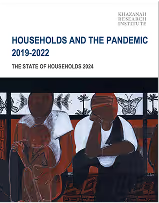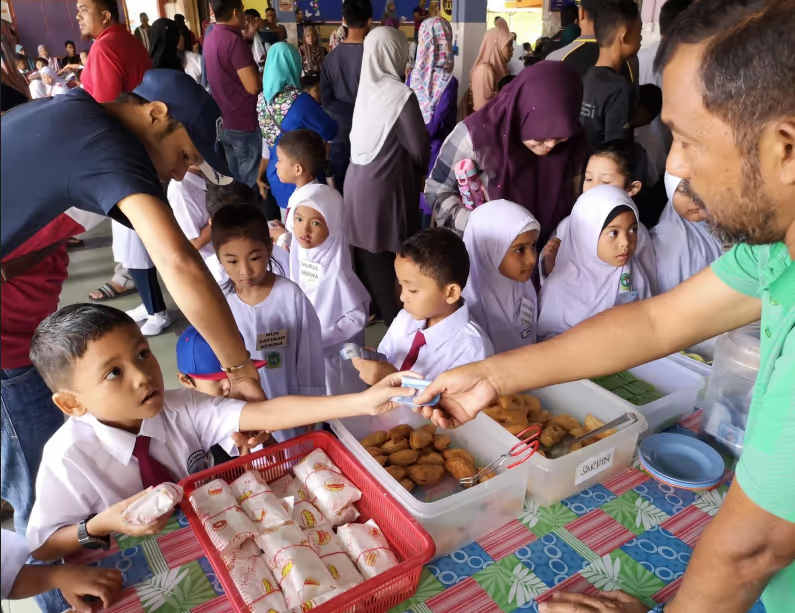
1. Introduction
Every year, governments in developed and developing countries, along with international organisations such as the World Food Programme (WFP) spend millions on school feeding programmes, i.e., the provision of food to school children. Programme designs vary and food distribution modalities can range from on-site morning meals to take-home food rations, depending on several factors including infrastructure constraints, among other things.
In Malaysia, the best-known school feeding programme is the Rancangan Makanan Tambahan (RMT) which gives free meals to primary school students from low-income households. Aside from RMT, other programmes include the parent-funded Program Hidangan Berkhasiat di Sekolah (HiTS). Despite the ubiquity of these programmes, we know little about why they are needed, how they are implemented and how effective they have been. Furthermore, recent discussions centre on expanding school feeding from a targeted programme to a universal one in Malaysia. This paper aims to give possible answers to these questions by understanding the rationale of running a school feeding programme in Malaysia and reviewing the aforementioned programmes.
2. Why have school feeding programmes?
2.1. Window of opportunityThe nutritional needs of children differ at every stage of life, from the first 1,000 days to adolescence. The most crucial period for child development is the first 1,000 days, i.e., from conception until around the second birthday. While ensuring good nutrition in the first 1,000 days remains the priority, ages five to 19 years old provides a second window of opportunity as it is a time of rapid physical development especially during adolescence with the start of puberty. During this period, children could make up for growth deficits suffered in early childhood with positive effects on children's cognitive development. This ability to correct childhood malnutrition is known as catch-up growth.
2.2. Hunger affects development and learningAs children enter their schooling period, they gain more autonomy in deciding what they eat, especially while they are at school. In 2017, a survey among school-going children mostly aged 10 to 17 years in Malaysia inquired about their dietary practices. Only 30% of the respondents eat breakfast every day while the remaining either have breakfast irregularly (60%) or not at all (10%). Worryingly, 66.5% of children who do not have breakfast at all attend school in the morning.
Energy is essential for concentration and participation in school. For hungry students, learning becomes more difficult. Breakfast skippers can eat by purchasing food in or outside schools, but there may be little to no healthy options.
2.3. Poor diets and nutritional statusReviewing children's dietary practices in Malaysia raises other red flags that require an urgent response. Fewer than one-third of 10 to 17-year-olds consume adequate fruits (31.5%), legumes (23.2%), milk and dairy products (23.3%) and vegetables (7.9%). In contrast, fast food consumption is common as 84.4% eat fast food one to six days weekly.
Additionally, statistics on children's nutritional outcomes give much cause for concern. Undernutrition affects how children grow and develop and is associated with impaired cognitive function, higher school absenteeism and poor school performance. In 2017, 8.2% of school-going children aged 10 to 17 years were stunted, i.e., too short for their age.
Another type of malnutrition, hidden hunger, i.e., deficiencies of essential micronutrients, undermines the health of children, adversely affecting their learning. A study of school children aged six to 17 by the Nutrition Society of Malaysia (2015) finds that more than half the children met at least 80% of the values prescribed in the 'Recommended Nutrient Intake for Malaysians' for iron, niacin, riboflavin, thiamine, vitamin A and vitamin C. However, only 30% of girls and 41% of boys had the recommended calcium intake.
Children in Malaysia also suffer from obesity. Being obese can lead to depression, early-onset diabetes and stigmatization. In 2017, one-third of school-going children aged 10-17 were overweight or obese based on their BMIs. Among ASEAN countries, Malaysia has the second-highest prevalence of obesity among children and adolescents aged five to 19 after Brunei.
As these children spend much of their time in school, a school-level intervention such as a school feeding programme is appropriate.
3. The impact of school feeding programmes
Generally, school feeding contributes to the nutrition and health needs of children, children's education and social development, social provisioning and improving local food agriculture.
3.1. HealthSchool feeding initiatives uphold food security and safety by ensuring the availability of and access to safe and nutritious food for kids. When combined with fortification, school feeding not only addresses hunger but also reduces micronutrient deficiencies and strengthens children's overall health.
3.2. EducationSchool feeding combines health with education benefits such as increasing school enrolment and attendance and improving academic performance.
3.3. SocialisationSchool feeding has served as a tool for social inclusion. One example is the Mid Day Meal Scheme in India which requires children of different castes to sit together and share common meals. Thus, the programme provides an avenue to address discrimination based on caste by having children eat together.
3.4. Local agricultureSchool feeding promotes local agricultural production. Linking school feeding to local producers is termed 'home-grown school feeding', and helps to stabilise markets, increases (and guarantees) farmers' incomes and promotes the production of healthy food.
3.5. Local communitySchool feeding also benefits communities by reducing households' food expenses, consequently increasing their disposable incomes.
4. Rancangan Makanan Tambahan
The RMT, or the Supplementary Feeding Programme, is an integrated effort led by the Ministry of Education (MOE) carried out in primary schools. According to the RMT guidebook by the MOE, the general goal is to supplement food provided at home to meet a fourth to a third of primary school children's daily meal requirements.
4.2. Target groupOnly Malaysian citizens enrolled in government primary schools or government-aided schools are eligible for RMT. To become eligible, students must meet at least one of the following criteria:
- Heads of pupils' households earn less than the poverty line income.
- Students in Orang Asli and Penan schools.
- Students with special needs.
4.3. Programme runThe programme runs for 190 school days in the year. RMT meals are provided before school starts for on-site consumption so that students do not begin the school day hungry.
4.4. FundingFunds are wholly provided by the MOE. Starting in 2015, the allocated budget per student is RM2.50 per day in Peninsular Malaysia and RM3 in Sabah and Sarawak.
4.6. MenuFood should be from the 20 menus listed in the Food Supply Agreement. Examples include nasi lemak, mi goreng and roti canai.
4.7. Program Susu SekolahBesides food, RMT students are automatically enrolled in the School Milk Programme/Program Susu Sekolah (PSS) which provides free milk. The PSS was launched in 1983 and is a collaborative programme between the MOE and local milk producers.
4.8. Programme evaluationPast studies suggest that RMT was well received by students and parents. The most notable impact of RMT is reducing protein-energy malnutrition among children. Additionally, mean attendance rates went up in schools with RMT compared to schools without.
4.9. Program Sarapan PagiIn August 2019, the then Education Minister, Dr Maszlee Malik, announced a universal school breakfast programme called Program Sarapan Pagi (PSP) was to launch in 2020. The programme caters free breakfast to all primary school pupils in government and government-aided schools and is supposed to run on top of the ongoing RMT programme. The first phase began on 20th January 2020 involving 100 schools around the country with a total of 37,000 students and 1,600 teachers.
5. Program Hidangan Berkhasiat di Sekolah
The Program Hidangan Berkhasiat di Sekolah (HiTS) is a school breakfast programme that relies on private funds, usually from parents. Parents must pay a fee to enrol their children in the programme. Certain schools have redirected government funds for RMT to pay for RMT students' participation in HiTS.
5.1. Foundational structuresPrior to running the programme, schools must have a canteen that meets the demands of HiTS and gain enough support from parents. The PIBG and school administrators must negotiate with canteen operators on the supply and price of food. One of the conditions stipulated is operators are not allowed to sell other foods aside from those for HiTS.
5.2. MenuThe menu for HiTS is drafted by nutritionists with at least 60 meals that can be chosen from and the meals served change daily. The aim is to provide a balanced meal at minimum cost.
5.5. Programme evaluationThe conditions and rules installed in the programme's design are to nudge students' behaviours and promote commendable traits. A study on HiTS combined with nutrition education, i.e., the SNP, shows that the programme improved the nutritional status and education of participating students. Students in the programme slightly lowered their BMI scores compared to the rapid increase among students who were not, suggesting that the programme facilitated steady, healthy growth instead of rapid, unhealthy growth leading to obesity. SNP students also showed faster improvements in cognitive performance and health-related 'quality of life' outcomes compared to non-SNP students.
6. Targeting versus universalism
One consideration when designing a programme's model is who should be the beneficiaries. RMT, the national school feeding programme fully funded by the government, is targeted for poor students. HiTS is voluntary, though some assistance is given to disadvantaged students subject to the availability of funds. PSP, on the other hand, was originally conceived to be a universal programme.
Targeting incurs lower total expenditure but increases the risk of exclusion error, whereby children in need are overlooked and excluded. The poverty line income (PLI) used to identify RMT-eligible students has been criticised for being too low and failing to reflect the reality of the poor.
Another issue with targeting in school feeding is the occurrence of school food shaming, a situation where recipients are stigmatised and ridiculed in front of their peers for receiving food assistance. Evidence suggests that this can be resolved by running a universal programme. In 2003, New York City changed its policy on school feeding by making breakfast free for all students, from a policy using differential pricing based on family income. Researchers found that participation increased for eligible students, suggesting that some eligible kids chose not to eat when the programme was just for poor kids.
However, poor nutrition and bad eating habits are not problems of the poor alone. In Johor, Kuala Lumpur and Putrajaya where absolute poverty is almost eradicated, stunting is still prevalent among Standard Four to Form Five students with figures reaching up to 8% in 2017.
The decision on whether a school feeding programme should be targeted or free for all is context-specific.
7. Concluding remarks
Malaysia requires interventions at schools to address two related problems involving children: poor eating habits and malnutrition. Experiences of school feeding show that providing free meals to students can resolve these issues and gives other benefits including improving education outcomes, better socializing students, invigorating food agriculture, generating higher and more stable incomes for food farmers, and assisting households by reducing food expenses and improving food supply.
To better assess and improve these programmes, more rigorous studies are needed. Most RMT studies were conducted in the late 20th century. HiTS is a relatively new programme that has shown promising findings but more should be done to validate its design.
There is an urgent need for better cooperation among the different ministries and with other public stakeholders in improving the implementation of school feeding. The Ministry of Education, the Ministry of Health and the Ministry of Agriculture and Agro-based Industry have direct stakes in improving school feeding and must better coordinate to ensure its success















_4.avif)